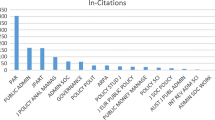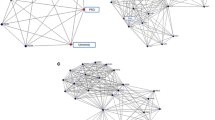Abstract
We apply social network analysis to display the characteristics of the networks resulting from bibliographic coupling of journals by the Chinese patent data of United States Patent and Trademark Office (USPTO) between 1995 and 2002. The networks of journals in all fields, the three strongly science-based fields (i.e. Biotechnology, Pharmaceuticals, and Organic Fine Chemistry), and the three weakly science-based fields (i.e. Optics, Telecommunications, and Consumer Electronics), have been analyzed from the global and the ego views, respectively. We study a variety of statistical properties of our networks, including number of actors, number of edges, size of the giant component, density, mean degree, clustering coefficient and the centralization measures of the network. We also highlight some apparent differences in the network structure between the subjects studied. Besides, we use the three centrality measures, i.e. degree, closeness, and betweenness, to identify the important journals in the network of all fields and those strongly science-based networks.
Similar content being viewed by others
References
Ahlgren, P., Jarneving, B. (2008), Bibliographic coupling, common abstract stems and clustering: A comparison of two document-document similarity approaches in the context of science mapping, Scientometrics, 76(2): 273–290.
Balconi, M., Breschi, S., Lissoni, F. (2004), Networks of invertors and the role of academia: an exploration of Italian patent data, Research Policy, 33: 127–145.
Bhattacharya, S., Meyer, M. (2003), Large firms and the science-technology interface: Patents, patent citations, and scientific output of multinational corporations in thin films, Scientometrics, 58(2): 265–279.
Callaert, J., Van Looy, B., Verbeek, A., Debackere, K., Thijs, B. (2006), Traces of prior art: An analysis of non-patent references found in patent documents, Scientometrics, 69(1): 3–20.
Cantner, U., Graf, H. (2006), Network of innovators in Jena: An application. Research Policy, 35: 463–480.
Carpenter, M. P., Narin, F. (1983), Validation study: Patent citations as indicators of science and foreign dependence, World Patent Information, 5: 180–185.
Chong, J.-Y., Min, H.-G., Park, M.-C. (2003), Patterns of knowledge production: the case of information and telecommunication sector, Scientometrics, 58(1): 115–128.
De Nooy, W., Mrvar, A., Batagelj, V. (2005), Exploratory Network Analysis with Pajek. Cambridge University Press, New York.
Egghe, L., Rousseau R. (2002), Co-citation, bibliographic coupling and a characterization of lattice citation networks, Scientometrics, 55(3): 349–361.
Godin, B. (1993), The Relationship between Science and Technology: A Bibliometric Analysis of Papers and Patents in Innovative Firms, unpublished D. Phil. thesis. University of Sussex, 1993.
Godin, B. (1995), Research and the practice of publication in industries, Research Policy, 25: 587–606.
Girvan, M., Newman, M. E. J. (2002), Community structure in social and biology networks. Proc. Natl. Acad. Sci, 99(12): 7821–7826.
Glänzel, W., Meyer, M. (2003), Patents cited in the scientific literature: An exploratory study of reverse. citation relations, Scientometrics, 58(2): 415–428.
Grupp, H. (1996), Spillover effects and the science base of innovations reconsidered: an empirical approach, Journal of Evolutionary Economics, 6: 175–197.
Grupp, H., Mont, G., Schmoch, U. (1996), Assessing different types of patent data for describing hightechnology export performance. In: Innovation, Patents and Technological Strategies (pp. 271–287). Paris: OECD.
Guan, J. C., He, Y. (2007), Patent-bibliometric Analysis on the Chinese Science — Technology Linkages, Scientometrics, 72(3): 403–425.
Huang M. H., Chiang L. Y., Chen, D. Z. (2003), Constructing a patent citation map using bibliographic coupling: A study of Taiwan’s high-tech companies, Scientometrics, 58(3): 489–506.
Inoue, H., Souma, W. Tamada, S. (2007), Spatial characteristics of joint application networks in Japanese patents, Physica A, 383(1): 152–157.
Knoke, D., Kuklinski, J. H. (1982), Network Analysis. Sage University Paper Series on Quantitative Applications in the Social Sciences, Sage, Newbury Park, CA.
Latour, B. (1987), Science in Action: How to Follow Scientists and Engineers through Society. Oxford: Oxford University Press.
Leydesdorff, L. (2004), The university-industry knowledge relationship: Analyzing patents and the science base of technologies. Journal of the American Society for Information Science & Technology, 55(11): 991–1001.
Leydesdorff, L. (2007a), Betweenness centrality as an indicator of the interdisciplinarity of scientific journals. Journal of the American Society for Information Science and Technology, 58(9): 1303–1319.
Leydesdorff, L. (2007b), Visualization of the ciatation impact environments of scientific journals: An online mapping exercise. Journal of the American Society for Information Science and Technology, 58(1): 25–38.
Leydesdorff, L., Zhou P. (2007), Nanotechnology as a field of science: Its delineation in terms of journals and patents. Scientometrics, 70(3): 693–713.
Metcalfe, A. S. (2006), The corporate partners of higher education associations: A social network analysis, Industry and Innovation, 13(4): 459–479.
Meyer, M. (2000), Does science push technology? Patents citing scientific literature. Research Policy, 29(3): 409–434.
Meyer, M. (2006), Measuring science-technology interaction in the knowledge-driven economy: the case of a small economy, Scientometrics, 66(2): 425–439.
Martinsons, M. G., Everett, J. E., Chan, K. (2001), Mapping the scholarly development of strategic management, Journal of Information Science 27: 101–110.
Narin, F., Noma, E. (1985), Is technology becoming science? Scientometrics, 7(3–6): 369–381.
Newman, M. E. J. (2001a), Scientific collaboration networks. I. Network construction and fundamental results, Physical Review E, 64: 016131 (8).
Newman, M. E. J. (2001b), Scientific collaboration networks.II. Shortest paths, weighted networks, and centrality, Physical Review E, 64: 016132 (7).
Newman, M. E. J. (2001c), The structure of scientific collaboration networks, Proc. Natl. Acad. Sci, 98: 404–409.
OECD (2004), Compendium of Patent Statistics, OECD, Paris.
Otte, E., Rousseau, R (2002), Social network analysis: a powerful strategy, also for the information sciences, Journal of Information Science, 28(6): 441–453.
Pavitt, K., Soete, L. (1980), Innovation activities and export shares: Some comparisons between industries and countries, In: Technical Innovation and British Economic Performance, K. Pavitt (Ed.), Macmillan, London.
Tijssen, R. J. W., Buter, R. K., Van Leeuwen, Th. N. (2000), Technological relevance of science: an assessment of citation linkages between patents and research papers, Scientometrics, 47(2): 389–412.
Van Looy, B., Debackere, K., Callaert, J., Tijssen, R., Van Leeuwen, T. (2006), Scientific capabilities and technological performance of national innovation systems: An exploration of emerging industrial relevant research domains, Scientometrics, 66(2): 295–310.
Van Looy, B., Zimmermann, E., Veugelers, R., Verbeek, A., Mello, J., Debackere, K. (2003), Do science-technology interactions pay off when developing technology? An exploratory investigation of 10 science-intensive technology domains, Scientometrics, 57(3): 355–367.
Verbeek, A., Debackere, K., Luwel, M., Andries, P., Zimmermann, E., Deleus, F. (2002), Linking science to technology: Using bibliographic references in patents to build linkage schemes, Scientometrics, 54(3): 399–420.
Wasserman, S., Faust, K. (1994), Social Network Analysis: Methods and Applications. Cambridge, NY: Cambridge University Press.
Author information
Authors and Affiliations
Corresponding author
Rights and permissions
About this article
Cite this article
Gao, X., Guan, J. Networks of scientific journals: An exploration of Chinese patent data. Scientometrics 80, 283–302 (2009). https://doi.org/10.1007/s11192-007-2013-4
Received:
Published:
Issue Date:
DOI: https://doi.org/10.1007/s11192-007-2013-4




